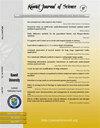Oblique stagnation point flow of hybrid nanofluid on a stretching sheet with modified thermal conductivity models and Darcy's law
IF 1.1
4区 综合性期刊
Q3 MULTIDISCIPLINARY SCIENCES
引用次数: 0
Abstract
Hybrid nanofluids have demonstrated improved thermal performance and stability across a wide range of applications, including thermal efficiency systems, solar collectors, energy production, nuclear processes, and enhanced heat transfer. Motivated by these promising applications, this study investigates two-dimensional incompressible oblique stagnation point flow over a stretching/shrinking sheet embedded in a porous medium. The analysis compares two widely used thermal conductivity models, the Yamada-Ota and Xue models, for hybrid nanofluids composed of graphene oxide () and iron oxide, magnetite () nanoparticles dispersed in a non-Newtonian engine oil (EO) base fluid. Additionally, the influences of thermal radiation, heat generation/absorption, and chemical reactions are incorporated to explore the heat and mass transfer characteristics. The governing equations are transformed into a system of ordinary differential equations using similarity transformations, and the resulting system is solved numerically via the fourth-order Runge-Kutta-Fehlberg integration method combined with an efficient shooting technique. The results reveal that increasing the magnetic field strength enhances the fluid temperature while reducing its velocity. Higher heat generation parameters lead to intensified thermal distribution, while lower permeability increases velocity instability. Quantitatively, the Xue model demonstrates a higher surface heat transfer rate than the Yamada-Ota model, and a larger Schmidt number reduces mass transfer rates. These insights are particularly valuable for optimizing heat and mass transfer in porous thermal management systems.
基于改进导热模型和达西定律的混合纳米流体在拉伸片上的斜滞止点流动
混合纳米流体在热效率系统、太阳能集热器、能源生产、核过程和强化传热等广泛应用中表现出了更好的热性能和稳定性。在这些有前景的应用的激励下,本研究研究了嵌入多孔介质的拉伸/收缩薄片上的二维不可压缩斜驻点流动。该分析比较了两种广泛使用的导热模型,即Yamada-Ota和Xue模型,这两种模型是由分散在非牛顿发动机油(EO)基液中的氧化石墨烯(GO)和氧化铁、磁铁矿(Fe3O4)纳米颗粒组成的混合纳米流体。此外,还考虑了热辐射、热产生/吸收和化学反应的影响,以探索传热传质特性。利用相似变换将控制方程转化为常微分方程组,利用四阶Runge-Kutta-Fehlberg积分法结合高效射击技术对控制方程组进行数值求解。结果表明,增大磁场强度,流体温度升高,速度降低;较高的产热参数导致热分布加剧,而较低的渗透率则增加了速度不稳定性。定量地,Xue模型比Yamada-Ota模型显示出更高的表面传热率,更大的施密特数降低了传质率。这些见解对于优化多孔热管理系统中的传热和传质特别有价值。
本文章由计算机程序翻译,如有差异,请以英文原文为准。
求助全文
约1分钟内获得全文
求助全文
来源期刊

Kuwait Journal of Science
MULTIDISCIPLINARY SCIENCES-
CiteScore
1.60
自引率
28.60%
发文量
132
期刊介绍:
Kuwait Journal of Science (KJS) is indexed and abstracted by major publishing houses such as Chemical Abstract, Science Citation Index, Current contents, Mathematics Abstract, Micribiological Abstracts etc. KJS publishes peer-review articles in various fields of Science including Mathematics, Computer Science, Physics, Statistics, Biology, Chemistry and Earth & Environmental Sciences. In addition, it also aims to bring the results of scientific research carried out under a variety of intellectual traditions and organizations to the attention of specialized scholarly readership. As such, the publisher expects the submission of original manuscripts which contain analysis and solutions about important theoretical, empirical and normative issues.
 求助内容:
求助内容: 应助结果提醒方式:
应助结果提醒方式:


